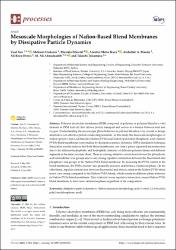| dc.contributor.author | Sen, Unal | |
| dc.contributor.author | Ozdemir, Mehmet | |
| dc.contributor.author | Erkartal, Mustafa | |
| dc.contributor.author | Kaya, Alaattin Metin | |
| dc.contributor.author | Manda, Abdullah A. | |
| dc.contributor.author | Oveisi, Ali Reza | |
| dc.contributor.author | Ali Aboudzadeh, M. | |
| dc.contributor.author | Tokumasu, Takashi | |
| dc.date.accessioned | 2022-03-05T09:11:51Z | |
| dc.date.available | 2022-03-05T09:11:51Z | |
| dc.date.issued | 2021 | en_US |
| dc.identifier.issn | 2227-9717 | |
| dc.identifier.uri | https //doi.org/10.3390/pr9060984 | |
| dc.identifier.uri | https://hdl.handle.net/20.500.12573/1242 | |
| dc.description | U. Sen was supported by JSPS RONPAKU (Dissertation PhD) program with ID No. TUR 11008. | en_US |
| dc.description.abstract | Polymer electrolyte membrane (PEM) composed of polymer or polymer blend is a vital element in PEM fuel cell that allows proton transport and serves as a barrier between fuel and oxygen. Understanding the microscopic phase behavior in polymer blends is very crucial to design alternative cost-effective proton-conducting materials. In this study, the mesoscale morphologies of Nafion/poly(1-vinyl-1,2,4-triazole) (Nafion-PVTri) and Nafion/poly(vinyl phosphonic acid) (Nafion-PVPA) blend membranes were studied by dissipative particle dynamics (DPD) simulation technique. Simulation results indicate that both blend membranes can form a phase-separated microstructure due to the different hydrophobic and hydrophilic character of different polymer chains and different segments in the same polymer chain. There is a strong, attractive interaction between the phosphonic acid and sulfonic acid groups and a very strong repulsive interaction between the fluorinated and phosphonic acid groups in the Nafion-PVPA blend membrane. By increasing the PVPA content in the blend membrane, the PVPA clusters' size gradually increases and forms a continuous phase. On the other hand, repulsive interaction between fluorinated and triazole units in the Nafion-PVTri blend is not very strong compared to the Nafion-PVPA blend, which results in different phase behavior in Nafion-PVTri blend membrane. This relatively lower repulsive interaction causes Nafion-PVTri blend membrane to have non-continuous phases regardless of the composition. | en_US |
| dc.description.sponsorship | JSPS RONPAKU (Dissertation PhD) program TUR 11008 | en_US |
| dc.language.iso | eng | en_US |
| dc.publisher | MDPIST ALBAN-ANLAGE 66, CH-4052 BASEL, SWITZERLAND | en_US |
| dc.relation.isversionof | 10.3390/pr9060984 | en_US |
| dc.rights | info:eu-repo/semantics/openAccess | en_US |
| dc.subject | dissipative particle dynamics | en_US |
| dc.subject | Nafion | en_US |
| dc.subject | mesoscale morphology | en_US |
| dc.subject | poly(1-vinyl-1,2,4-triazole) | en_US |
| dc.subject | poly(vinylphosphonic acid) | en_US |
| dc.title | Mesoscale Morphologies of Nafion-Based Blend Membranes by Dissipative Particle Dynamics | en_US |
| dc.type | article | en_US |
| dc.contributor.department | AGÜ, Mühendislik Fakültesi, Malzeme Bilimi ve Nanoteknoloji Mühendisliği Bölümü | en_US |
| dc.contributor.authorID | 0000-0002-1940-8749 | en_US |
| dc.contributor.institutionauthor | Kaya, Alaattin Metin | |
| dc.identifier.volume | Volume 9 Issue 6 | en_US |
| dc.relation.journal | PROCESSES | en_US |
| dc.relation.publicationcategory | Makale - Uluslararası - Editör Denetimli Dergi | en_US |


















